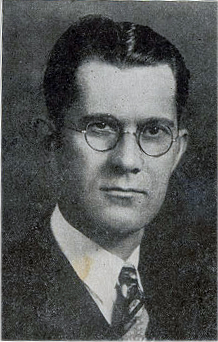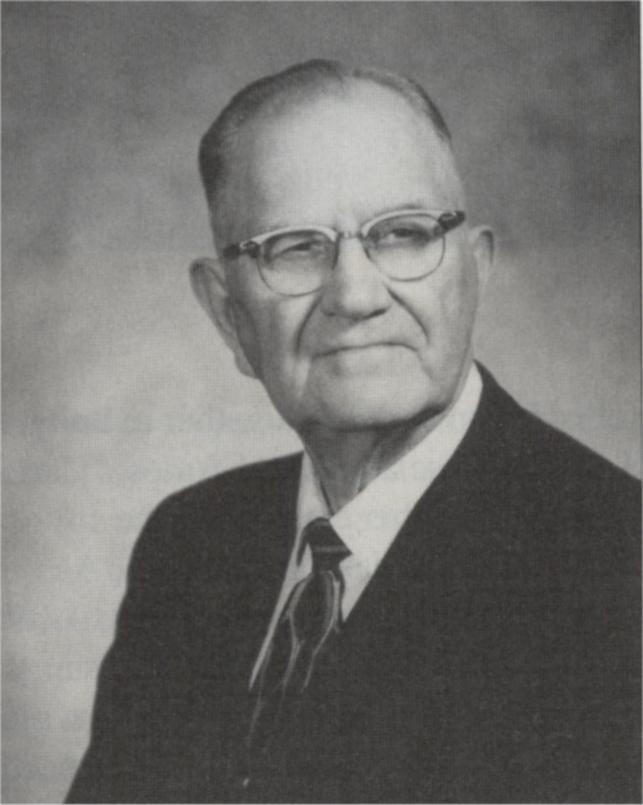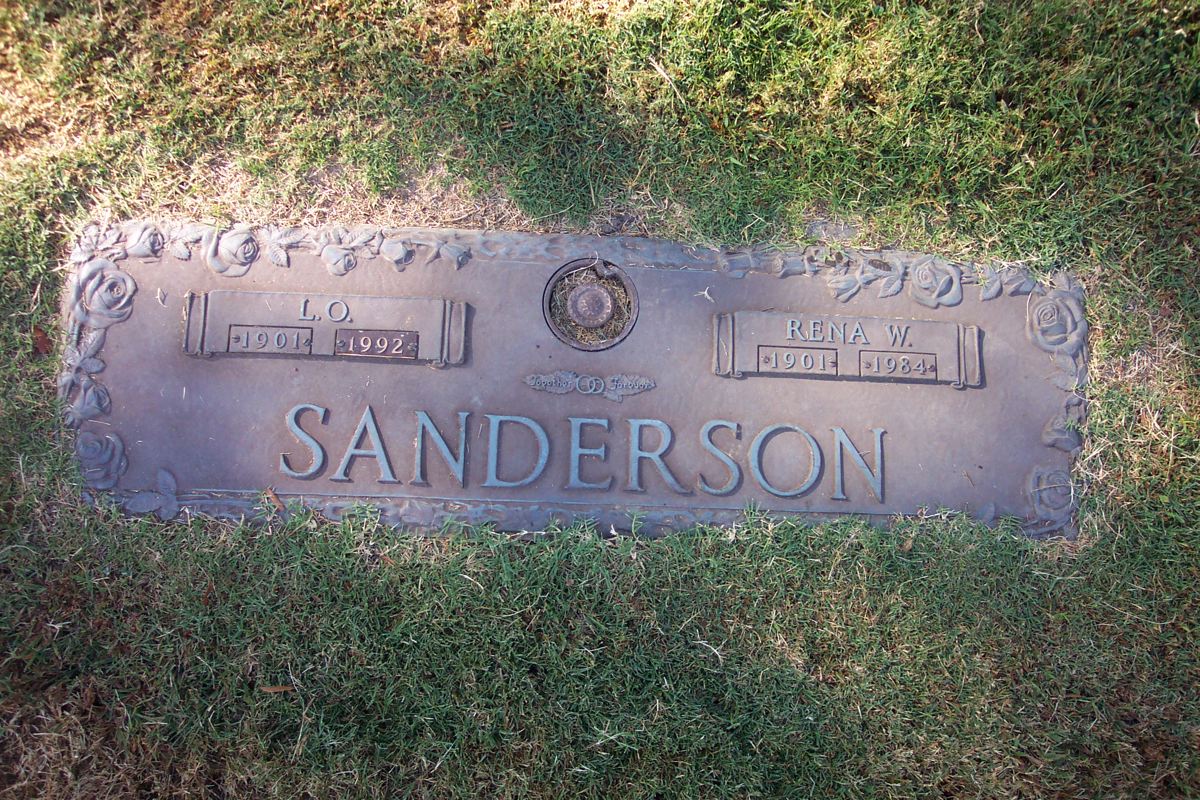Lloyd Otis Sanderson
1901-1992

![]()
"The Lord Has Been Mindful Of Me"
An Autobiography Of L. O. Sanderson
My father was a singing teacher. Because he was not allowed to have musical instruments as a young man, he vowed that when he had a family of his own, the children would have access to instruments. During my time at home, we had a piano, an organ, a violin, guitar, mandolin, harmonica and Jew's harp. We all learned to sing and play early in life.
I was taught to note read at age 5 by my mother. Before that, I sang much by rote. This really was my first exposure to the theory of music. My father soon began to teach me song leading. However, with 55 years difference in our ages, father soon tired of the job of teaching and playing with us.
At age 4, I entered public schools. Having weighed 13 pounds, 8 ounces at birth, I was large for my age. Besides that, there were no age limitations or entrance in those days. By age 6, I was beginning the fourth grade. It did not take long for me to complete the eighth grade. In a one-teacher school, we were allowed to go as fast as we could, and I was an "eager beaver." Of course, I was too young to quit school after the eighth grade, so I continued for another year.
When my cousin, L.E. McElroy, came to Union Grove to teach, he had a bachelor's degree and was working on his master's. He urged me to take high school work. With proper books provided by him, I finished two years of high school with good marks. That was the last of secular education for several years.
I began going to summer music normals where for two or three months we studied music day and night. Professor Scott Crotts was a popular teacher in those days, and Samuel J. Spencer also joined the summer school. I received a diploma for teaching and began my first singing school on the day I became 15. My father had put me on my own at age 11; thereafter I bought my own clothes and paid my own tuition and for private lessons.
During the four years of this music normal work, I would pick cotton and work at a sawmill to gain the necessary cash. Finally, I had enough money to do more schooling, and for four years I studied more intensely. I attained a graduate status in music (equal now to a bachelor's degree - 127 hours) at age 18.
Father died soon after, and I elected to be with my mother and the two younger children. We moved to Bono, a small town on the Frisco Railroad. I became the choir director for the First Methodist church and worked for the Bono Mercantile Co. part time.
My father belonged to the Methodist church, and Mother was a member of the church of Christ. There was a congregation of Christians in Bono, so she was pleased to move there. When I came home in 1919, I decided to finish my high school work and did so at the Bono High School.
Not long after, I learned and accepted the truth of God concerning salvation. My older brother and younger sister were members of the church along with our mother. I had previously declined to listen. Through a good friend, Robert Cherry, the main clerk at Bono Mercantile, I finally came to know and love the truth that makes men free. This meant the end of choir directing for the Methodist church and soon after the work at the Mercantile. But I began to get calls to lead singing in gospel meetings and really did not miss any work at all. The local church of Christ immediately employed me to direct singings for a big tent meeting, and other calls came in plentifully.
In the spring of 1923, after I became a Christian in July 1922, J.N. Armstrong, president of Harper (Kansas) Christian College, offered me a job as music director and an opportunity to do college work. I accepted the work but made so little cash that I didn't go home even at Christmas time. In 1924, Harper College merged with Arkansas Christian College of Morrilton, Ark., to form Harding College. I held the same obligation with Harding from 1924 to 1928.
While at Harper, I took a year of voice with Inez Dodds Barber of Friends University. She came to Harper for classes and private lessons. During the four years at Harding in Morrilton, I completed two years of work at Little Rock Conservatory of Music. For two years, I was also affiliated with the Arkansas Music Teachers Association until I left the state in 1928.
At Harper, I met Rena Raye Woodring, a sister of the Harper College librarian, and we began dating. She came to Harding in the fall of 1923, and we began to make plans. She took school teaching work from 1925-1927, and we were married Aug. 29, 1927. We stayed one more year at Harding for Rena to finish her bachelor's work and then went to Springfield, Mo., to serve the church. We were there for seven years and returned in 1950 for another nine years.
I enrolled at Southwest Missouri State College (now a university) for two years while serving the church. I won honors in three departments: argumentation (debating), extemporaneous speaking and orations. While at Springfield (1928-1935), I also did some music work (mainly history) by correspondence from the University of Arkansas.
In 1935, we moved to Nashville, Tenn., where I became business manager for the Gospel Advocate Co. For three years I also taught part time at David Lipscomb College. Gradually, the work at the Gospel Advocate became heavier until my full time was required at the Gospel Advocate. At the beginning of 1938, John T. Hinds, editor of the Gospel Advocate, died, and I served as editor until B.C. Goodpasture came in 1939. I continued on as music editor.
People thought of me more as a businessman, but I preferred church work. I resigned from the Gospel Advocate to be effective in August 1942 in order to do full time church work. We served churches in Springfield, Mo.; Columbia, Tenn.; Little Rock, Ark.; and Amarillo, Texas, as the local minister. Always we had a good work. In 1946, while in Tulsa, an opportunity arose. The Central church in Norman made us an offer to serve there and to attend the University of Oklahoma. This we did.
My work in and with the church has been in the form of local ministry and evangelistic efforts such as gospel meetings. I had the opportunity to be closely associated with great and good men in meetings, with many anywhere from one to a dozen times. Among these were J.N. Armstrong, N.B. Hardeman, G.C. Brewer, Horace Busby, Foy E. Wallace, Roy Cogdill, F.B. Srygley, B.C. Goodpasture, S.H. Hall, E.M. Borden, C.R. Nichol, C.L. Wilkerson, M.S. Mason, A.G. Freed, H.A. Dixon, C.E. McGaughay, L.S. White, E.A. Elam, H. Leo Boles and not a few others.
SONG WRITING
I wrote my first song at age 14, but it really wasn't worth publishing. During the latter teens of the century, a number of my compositions were published by Hildebrand-Burnett Co. and Hartford Music Co. For four years I was part of a quartet made up of my brother and me and two others.
I have written some 500 songs and hymns. At least 50 children's songs appeared in Gospel Advocate publications as "A Guide to Child Activity." The better part of my writings appeared in hymnals and songbooks after 1934. I have written lyrics under a pen name, Vana R. Raye, a name fashioned from my companion's name. Originally, she had been Avana Raye, but this was changed to Rena Raye.
Some of my compositions have been sold to others, mainly in the commercial field, other religious publishers, and a few to the brethren. I have also allowed usage of new material in other publications, but under my own copyright. Only a few of these have found their way into a field of demand.
Among those in the church who wrote songs and hymns, I knew most of them. I never met Austin Taylor (writer of "Closer to Thee"), William M. Golden nor those associated with Trio Publishing Co., Quartet Publishing Co., and Firm Foundation. I did know E.L. Jorgenson, W.W. Slater, Albert Brumley and Tillitt S. Teddlie.
SONG BACKGROUNDS
Many are interested in the backgounds of my songs. I offer a few.
- "Be With Me, Lord" is perhaps my most popular hymn. In Springfield, in 1934, I was working on my first hymnal for the Gospel Advocate Co. At about 2 A. M. one Tuesday a melody came to mind. I found it difficult to get rid of it. So I stopped and wrote it down, lest I forget. Even then, I kept seeing or sensing the harmony, which bothered my work; so I turned and wrote it out completely. It is a rare meter - 11 notes in a phrase, 10 in the next, 11 in the third, and again 10 in the fourth. I couldn't come up with or find words to fit it. About eight days passed when I received a letter from Thomas O. Chisholm, who had long written words for me. He wrote that he had retired on the same night I was working, and a theme for a poem seemed to command his attention. Finally after midnight of that same Tuesday, he got up and wrote out the poem. He was sending it to me to see what I thought of it. It was an exact fit for my music. I bought the poem, and the twain have been together since.
- "The Lord Has Been Mindful of Me." When I was converted in 1922, I first thought I had made a sacrifice. I left a good work, providing good pay and good friends and boosters with an opportunity to receive worthy promotion. I was involved in fund-raising for the Methodist church with a goal of $75 million for mission work. But I left that and became a member of the church which had suffered brunts from denominationalism everywhere. But I didn't really sacrifice. I didn't miss a week's work by the change. I found so many true associations. I had a thousand mothers in spiritual Israel. I had brothers and sisters by the thousands who were nearer and dearer than flesh kin. I was led into endeavors that far outstripped what I had been doing. I decided I had been wonderfully blessed. With this feeling, I wrote "The Lord Has Been Mindful of Me." You can see this story in the lyrics. In days of shadow, troubles and darkness, the Lord has still been mindful. More than any grief, sorrow, adversity or sacrifice, I have been blessed. I'm rich, saved, happy, in good heath, prosperous in many ways, homes open to me and friends of greater value than all the wealth of the world. Indeed, God blesses and blesses again. And this was the song of my heart.
- "Buried With Christ" (or "A New Creature"). After my conversion, I tried to influence others. Thomas O. Chisholm was among them. We exchanged many letters on religious convictions. We seemed agreed. He had a similar background, but we lived far apart. I was in Springfield and he in Vineland, N.J. Long trips were "out" in those days. So to know if I might have made an impression, I asked him to write me a poem on Romans 6:3-18. The words to "Buried With Christ" were the result. I do not see how a true Methodist could write such meaningful words.
- "Bring Christ Your Broken Life." I had written the music but could not by myself come up with acceptable lyrics. I sent the music to T.O. Chisholm and asked him to see what he thought most appropriate for words. This poem was the result. This has become a much-used song, an exhortation and an appeal to one and all as to the faithful Savior who can handle any situation.
- "Every Cloud Has a Silver Lining" is another effort at showing my happiness with Christ and His church and learning to deal with whatever disappointments come along the way.
- "Where Livest Thou" is based on a sermon by C.L. Wilkerson, one of the finest men I have ever known. In a sermon, he asked a question and then answered it. The poem shows this by its markings.- Many other promptings hold some interest. "My Idle Words" was written somewhat by demand. The owners of "If I have Wounded Any Soul Today" would not let me use this song unless I gave up another, such as "Have Thine Own Way" or "Take Time to Be Holy." They allowed only six of their copyright songs in another's compilation. So I wrote a song to fill the need on the subject.
- "Take Me Home, Father" has a long story back of it. An 80-year-old gospel preacher, after his wife's death, was in a coma. He did not wish to live any longer because all he knew and loved and who loved and cared so much for him was gone. He had no desire to live when I told him of his wife's death. He died two days later. I had a like feeling. When I grow useless, burdensome, helpless, take me home, Father, take me home! I still feel the same way as when it was written.
Our thanks to Leon Sanderson for sending this never-before-published autobiography of his father.
-Gospel Advocate, Vol. CXLVI, No. 9, September, 2004, pages. 26-28
![]()
Obituary For L. O. Sanderson
 L. O. Sanderson, former music editor of the Gospel Advocate Company, died Jan. 17 at his home in Memphis. Tenn. He was born May 18, 1901, in Craighead County, Ark., to James P. and Lucy Hunt Sanderson.
L. O. Sanderson, former music editor of the Gospel Advocate Company, died Jan. 17 at his home in Memphis. Tenn. He was born May 18, 1901, in Craighead County, Ark., to James P. and Lucy Hunt Sanderson.
Sanderson was convened in 1922 at the age of 21 and immediately was employed to lead singing at the Bono, Ark., Church of . Christ. One year later Sanderson went to teach at , Harper Christian College in Kansas, which later combined with Arkansas Christian College in Morrillon, Ark., to form Harding College in 1924.
It was in Harper at graduation time in 1924 that Sanderson met Rena Raye Woodring of Texola, Okla. They were married Aug. 29. 1927. Both graduated from Harding in 1928.
The Sandersons worked in Springfield. Mo. until 1935, at which time they moved to Nashville. Tenn., where Sanderson began working for the Gospel Advocate and teaching part time at David Lipscomb College. He had already been employed by the Gospel Advocate since 1933 as music editor.
Sanderson wrote more than 400 hymns including "Buried with Christ." "The Lord Has Been Mindful of Me," "Pray All The Time," "I'll Never Forsake My Lord" and "Be with Me Lord."
The Sandersons also worked in Tulsa, Okla.; Norman. Okla.; Utile Rock, Ark;. Wichita. Kan.; Amarillo. Texas; Columbia. Tenn.; Memphis and Atlanta.
Sanderson was preceded in death by his daughter Lloydene, who died of cancer Aug. 2, 1984; and his wife, Rena Raye, who died Aug. 15. 1984, after being hit by a car while crossing the street. The same accident left L. O. crippled.
He is survived by his wife, Vesta Stowe Sanderson. whom he married in 1988; his son, Leon, of Memphis: six grandchildren and two great-grandchildren. Funeral services were conducted at the Wooddale church in Memphis. Participants in the service were Paul Epps, Tex Stevens, Edward P. Myers. Jim Howard and Jim Rogers.
Burial was at Memorial Park Cemetery. The family requests that memorials be sent to Harding University Graduate School in Memphis or Harding University in Searcy. Ark. Scholarships are established in the Sanderson name at both schools.
-Gospel Advocate, March, 1992, page 29
![]()
Directions To The Grave Of L. O. Sanderson
L. O. and Rena W. Sanderson are buried in the Memorial Park Cemetery in Memphis, Tennessee. Take I-240 to Poplar Ave exit. Go west and the cemetery will be on your right. Location: Garden Of Meditation, North Section 2, Lot 28, Plot #3. See map to locate section of cemetery where grave is located. Look in the center of the section for a marble park bench with, "In Memory Of Mike Vincent" inscribed on it. Count seven markers to the west and to find the Sanderson plot.
See Memorial Park Webpage and Map To Sanderson Grave Here!
GPS Coordinates
35°06'48.0"N 89°52'29.0"W
or D.d. 35.113333,-89.874733
Grave Faces North
Accuracy To 14ft.
View Larger Map

SANDERSON
L. O. - 1901-1992
Rena W. - 1901-1984
![]()

